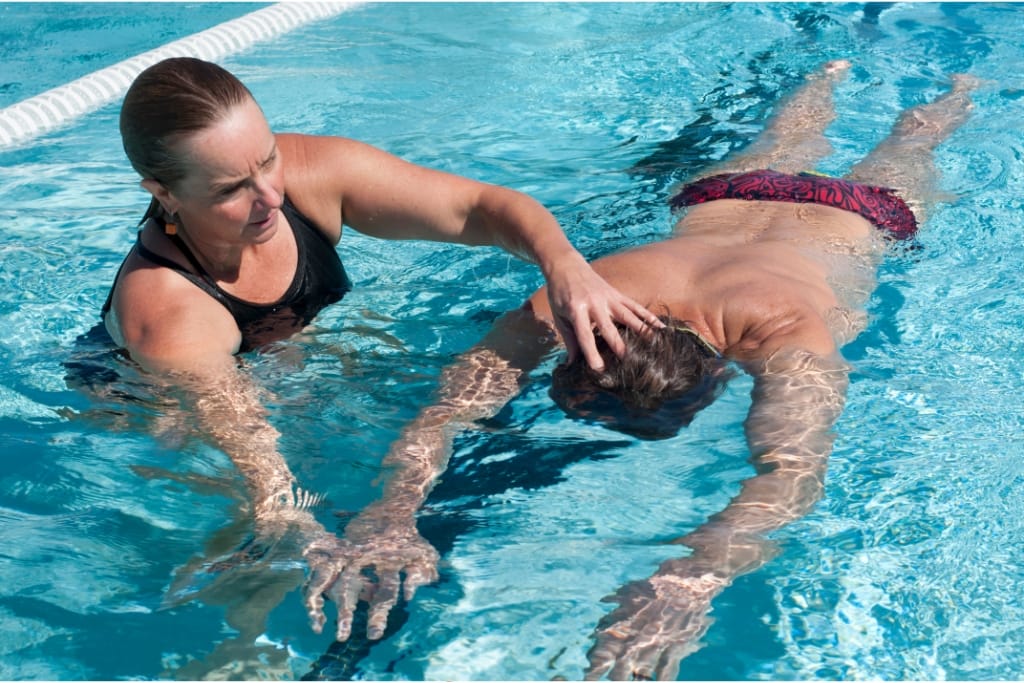Learning to swim is an invaluable skill that brings both enjoyment and practical benefits to your life, from enhancing your fitness to giving you confidence in the water.
With the right approach, even beginners can quickly build the foundations needed to feel comfortable and capable in any aquatic environment.
Whether you’re aiming to master the basics or improve your technique, the following tips will help you get started and make meaningful progress—keep reading to learn how you can take the first steps toward becoming a confident swimmer!
1)) Hire A Swim Instructor
Working with a swim instructor is one of the most effective ways to build a strong foundation in swimming.
A skilled instructor can tailor lessons to your specific needs, ensuring you learn proper techniques while boosting your confidence in the water.
They can also observe and correct any mistakes in real time, which helps prevent the development of bad habits that might otherwise hinder your progress.
Whether you're completely new to swimming or looking to refine your basics, a structured approach with professional guidance can make all the difference.
With consistent practice under the watchful eye of an expert, you'll be well on your way to achieving your swimming goals.
2)) Choose Proper Swimwear
Wearing the right swimwear is essential for comfort and performance in the water.
Properly fitting swimwear allows for unrestricted movement, reducing drag and helping you focus on your technique without unnecessary distractions.
Look for materials designed for swimming, such as chlorine-resistant fabrics, to ensure durability and long-lasting use.
A well-chosen swimsuit can enhance your confidence by providing a secure and comfortable fit.
Investing in the right swimwear is a simple but important step toward a smoother and more enjoyable learning experience.
3)) Master Breathing Techniques
Mastering breathing techniques is a fundamental aspect of becoming a confident swimmer.
Learning to control your breathing not only increases your endurance but also helps you remain calm and focused while in the water.
Start by practicing rhythmic breathing, inhaling through your mouth above the water and exhaling through your nose or mouth while submerged.
This will create a natural and efficient breathing pattern, minimizing the risk of feeling out of breath or overwhelmed.
Over time, good breathing habits will improve your overall coordination and make swimming feel more natural, setting the stage for steady progress in your skills.
4)) Practice Floating
Learning to float is an essential skill for building confidence and safety in the water.
Floating helps you develop balance, body awareness, and relaxation, which are crucial for progressing to other swimming techniques.
Begin by practicing on your back in shallow water, keeping your body straight and your arms and legs relaxed.
Take slow, even breaths to remain calm and allow the water to support you.
Becoming comfortable with floating will increase your ability to remain buoyant and conserve energy, giving you a solid foundation for mastering additional swimming skills.
5)) Learn Basic Strokes
Learning basic strokes is a crucial step in developing your swimming skills and building overall efficiency in the water.
Start with foundational strokes such as the freestyle, backstroke, and breaststroke, focusing on proper form and technique for each.
These strokes not only improve your ability to move through water effectively but also enhance your coordination and strength.
Practicing regularly and breaking the strokes into smaller, manageable components—like arm movements, leg kicks, and breathing—will make the learning process more approachable.
With consistent effort, these core swimming techniques will empower you to swim with greater ease and confidence.
6)) Use Swim Aids Wisely
Using swim aids wisely can greatly enhance your learning experience in the water.
Tools like kickboards, pull buoys, and fins can help you isolate and strengthen specific parts of your technique, such as your kick or arm stroke, making it easier to build muscle memory.
These aids also provide additional support, which can boost your confidence and allow you to focus on the correct form without fear or hesitation.
It is important to use swim aids as temporary learning tools and gradually reduce reliance on them as you improve.
Thoughtful use of these aids will help you develop proper swimming skills and advance toward swimming independently with ease.
7)) Improve Kicking Technique
Developing a strong and efficient kicking technique is vital for effective swimming and overall propulsion in the water.
Focus on generating power from your hips rather than your knees, keeping your legs straight but relaxed with a slight bend.
Point your toes to create a streamlined motion, minimizing resistance while maximizing efficiency.
Practice your kicks using tools like a kickboard to isolate your leg movements and ensure proper form.
Consistent attention to your kicking technique will significantly enhance your propulsion, allowing you to swim faster and with greater endurance.
8)) Focus On Arm Movements
Focusing on arm movements is essential for mastering swimming techniques and improving your efficiency in the water.
Proper arm movements help propel you forward while maintaining balance and stability.
Start by practicing the correct arm placement, ensuring your hands enter the water smoothly and extend fully before pulling.
Your arm strokes should follow a fluid, circular motion, with your elbows high during the recovery phase.
Pairing these movements with proper hand positioning will reduce drag and increase propulsion.
Paying attention to your arm technique will refine your swimming skills, allowing you to glide through the water more effectively and with greater confidence.
9)) Practice Consistency
Practicing consistency is key to developing and maintaining strong swimming skills over time.
Dedicate regular time to your swimming practice, focusing on improving technique, building endurance, and reinforcing the fundamentals you’ve learned.
Break down your goals into small, achievable milestones to stay motivated and track your progress.
Regular repetition allows your body to build muscle memory, making movements feel natural and efficient.
Keeping a steady practice routine will not only enhance your skills but also help you build confidence and stay committed to continual improvement in the water.
10)) Maintain Body Alignment
Maintaining proper body alignment is essential for swimming efficiently and reducing drag in the water.
Keep your body flat and streamlined, with your head in a natural, neutral position that aligns with your spine.
Avoid lifting your head too high, as this can cause your hips and legs to drop, creating unnecessary resistance.
Engage your core muscles to stabilize your body, ensuring a smooth and balanced position.
Practicing drills that emphasize alignment, such as using a kickboard or swimming with a snorkel, can help build awareness of your posture.
Prioritizing body alignment will allow you to move through the water effortlessly and conserve energy for longer swims.
11)) Start In Shallow Water
Starting in shallow water is a practical and confidence-boosting approach when learning to swim.
Shallow water provides a safe environment where you can practice fundamental skills such as floating, basic strokes, and breathing techniques without feeling overwhelmed.
This controlled space allows you to focus on mastering the basics while minimizing the fear of deep water.
Gradually, as you build confidence and refine your skills, you can transition to deeper areas at your own pace.
Beginning in shallow water ensures a solid foundation, setting you up for greater success as you continue to progress in your swimming journey.
12)) Warm Up And Cool Down
Warming up and cooling down are vital components of any swimming routine to prevent injuries and enhance performance.
A proper warm-up gradually increases your heart rate, improves blood circulation to your muscles, and prepares your body for more intense activity.
Incorporate dynamic stretches and light swimming exercises to loosen joints and muscles.
Similarly, a cool-down aids in recovery after your session, allowing your heart rate and breathing to return to normal while reducing muscle stiffness.
Focus on slow, relaxed strokes and gentle stretches to ease your body out of exertion.
Integrating warm-up and cool-down exercises into your routine ensures you stay healthy and maximize the benefits of your swimming practice.
Conclusion
Mastering swimming requires dedication, patience, and attention to detail.
By focusing on key aspects like technique, consistency, and proper preparation, you can build a strong foundation for success in the water.
Whether you’re refining your strokes, honing your body alignment, or practicing regularly, each step contributes to greater confidence and skill.
With persistence and the right approach, swimming can become an enjoyable and rewarding experience that fosters both physical fitness and mental well-being.
Download Our Free E-book!







